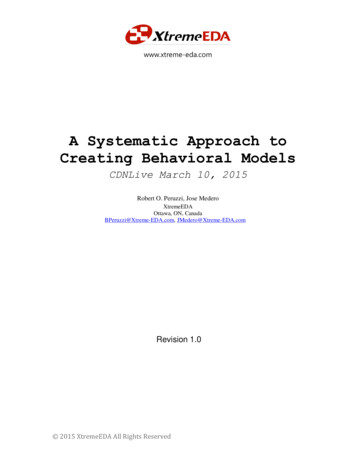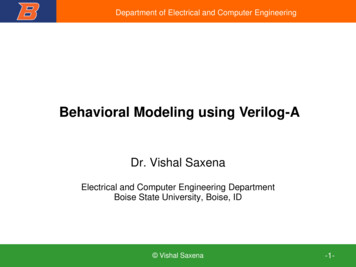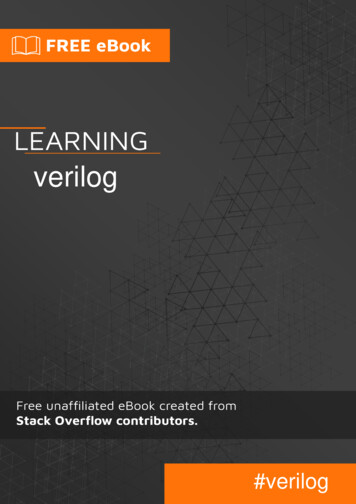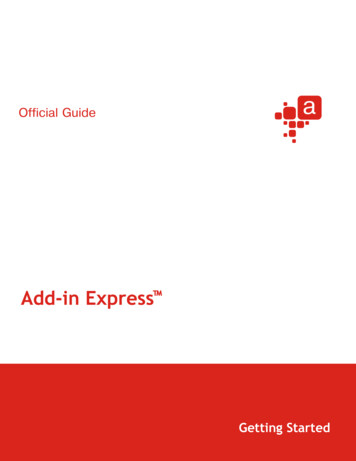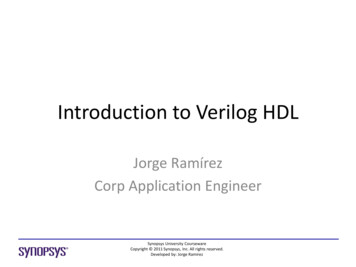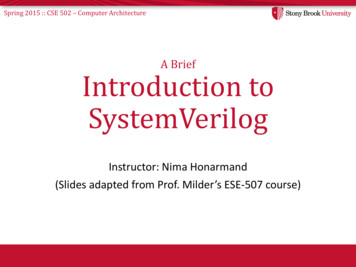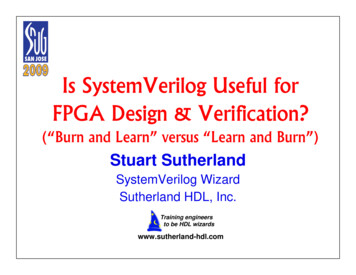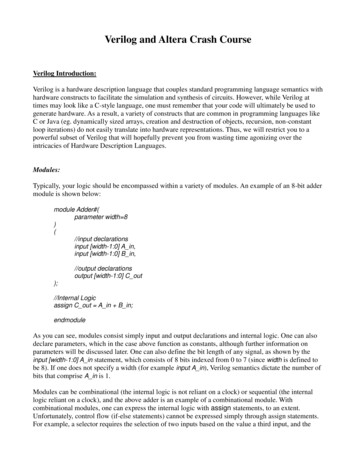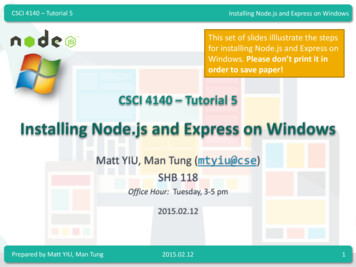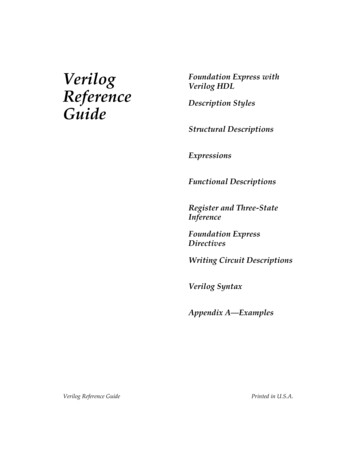
Transcription
VerilogReferenceGuideFoundation Express withVerilog HDLDescription StylesStructural DescriptionsExpressionsFunctional DescriptionsRegister and Three-StateInferenceFoundation ExpressDirectivesWriting Circuit DescriptionsVerilog SyntaxAppendix A—ExamplesVerilog Reference GuidePrinted in U.S.A.
Verilog Reference GuideRThe Xilinx logo shown above is a registered trademark of Xilinx, Inc.FPGA Architect, FPGA Foundry, NeoCAD, NeoCAD EPIC, NeoCAD PRISM, NeoROUTE, Timing Wizard, TRACE,XACT, XILINX, XC2064, XC3090, XC4005, XC5210, and XC-DS501 are registered trademarks of Xilinx, Inc.The shadow X shown above is a trademark of Xilinx, Inc.All XC-prefix product designations, A.K.A. Speed, Alliance Series, AllianceCORE, BITA, CLC, Configurable LogicCell, CORE Generator, CoreGenerator, CoreLINX, Dual Block, EZTag, FastCLK, FastCONNECT, FastFLASH,FastMap, Foundation, HardWire, LCA, LogiBLOX, Logic Cell, LogiCORE, LogicProfessor, MicroVia, PLUSASM,PowerGuide, PowerMaze, QPro, RealPCI, RealPCI 64/66, SelectI/O, Select-RAM, Select-RAM , Smartguide,Smart-IP, SmartSearch, Smartspec, SMARTSwitch, Spartan, TrueMap, UIM, VectorMaze, VersaBlock,VersaRing, Virtex, WebLINX, XABEL, XACTstep, XACTstep Advanced, XACTstep Foundry, XACT-Floorplanner,XACT-Performance, XAM, XAPP, X-BLOX, X-BLOX plus, XChecker, XDM, XDS, XEPLD, Xilinx FoundationSeries, XPP, XSI, and ZERO are trademarks of Xilinx, Inc. The Programmable Logic Company and TheProgrammable Gate Array Company are service marks of Xilinx, Inc.All other trademarks are the property of their respective owners.Xilinx, Inc. does not assume any liability arising out of the application or use of any product described or shownherein; nor does it convey any license under its patents, copyrights, or maskwork rights or any rights of others.Xilinx, Inc. reserves the right to make changes, at any time, in order to improve reliability, function or design andto supply the best product possible. Xilinx, Inc. will not assume responsibility for the use of any circuitry describedherein other than circuitry entirely embodied in its products. Xilinx, Inc. devices and products are protected underone or more of the following U.S. Patents: 4,642,487; 4,695,740; 4,706,216; 4,713,557; 4,746,822; 4,750,155;4,758,985; 4,820,937; 4,821,233; 4,835,418; 4,855,619; 4,855,669; 4,902,910; 4,940,909; 4,967,107; 5,012,135;5,023,606; 5,028,821; 5,047,710; 5,068,603; 5,140,193; 5,148,390; 5,155,432; 5,166,858; 5,224,056; 5,243,238;5,245,277; 5,267,187; 5,291,079; 5,295,090; 5,302,866; 5,319,252; 5,319,254; 5,321,704; 5,329,174; 5,329,181;5,331,220; 5,331,226; 5,332,929; 5,337,255; 5,343,406; 5,349,248; 5,349,249; 5,349,250; 5,349,691; 5,357,153;5,360,747; 5,361,229; 5,362,999; 5,365,125; 5,367,207; 5,386,154; 5,394,104; 5,399,924; 5,399,925; 5,410,189;5,410,194; 5,414,377; 5,422,833; 5,426,378; 5,426,379; 5,430,687; 5,432,719; 5,448,181; 5,448,493; 5,450,021;5,450,022; 5,453,706; 5,455,525; 5,466,117; 5,469,003; 5,475,253; 5,477,414; 5,481,206; 5,483,478; 5,486,707;5,486,776; 5,488,316; 5,489,858; 5,489,866; 5,491,353; 5,495,196; 5,498,979; 5,498,989; 5,499,192; 5,500,608;5,500,609; 5,502,000; 5,502,440; 5,504,439; 5,506,518; 5,506,523; 5,506,878; 5,513,124; 5,517,135; 5,521,835;5,521,837; 5,523,963; 5,523,971; 5,524,097; 5,526,322; 5,528,169; 5,528,176; 5,530,378; 5,530,384; 5,546,018;5,550,839; 5,550,843; 5,552,722; 5,553,001; 5,559,751; 5,561,367; 5,561,629; 5,561,631; 5,563,527; 5,563,528;5,563,529; 5,563,827; 5,565,792; 5,566,123; 5,570,051; 5,574,634; 5,574,655; 5,578,946; 5,581,198; 5,581,199;5,581,738; 5,583,450; 5,583,452; 5,592,105; 5,594,367; 5,598,424; 5,600,263; 5,600,264; 5,600,271; 5,600,597;5,608,342; 5,610,536; 5,610,790; 5,610,829; 5,612,633; 5,617,021; 5,617,041; 5,617,327; 5,617,573; 5,623,387;5,627,480; 5,629,637; 5,629,886; 5,631,577; 5,631,583; 5,635,851; 5,636,368; 5,640,106; 5,642,058; 5,646,545;5,646,547; 5,646,564; 5,646,903; 5,648,732; 5,648,913; 5,650,672; 5,650,946; 5,652,904; 5,654,631; 5,656,950;5,657,290; 5,659,484; 5,661,660; 5,661,685; 5,670,896; 5,670,897; 5,672,966; 5,673,198; 5,675,262; 5,675,270;5,675,589; 5,677,638; 5,682,107; 5,689,133; 5,689,516; 5,691,907; 5,691,912; 5,694,047; 5,694,056; 5,724,276;5,694,399; 5,696,454; 5,701,091; 5,701,441; 5,703,759; 5,705,932; 5,705,938; 5,708,597; 5,712,579; 5,715,197;5,717,340; 5,719,506; 5,719,507; 5,724,276; 5,726,484; 5,726,584; 5,734,866; 5,734,868; 5,737,234; 5,737,235;5,737,631; 5,742,178; 5,742,531; 5,744,974; 5,744,979; 5,744,995; 5,748,942; 5,748,979; 5,752,006; 5,752,035;5,754,459; 5,758,192; 5,760,603; 5,760,604; 5,760,607; 5,761,483; 5,764,076; 5,764,534; 5,764,564; 5,768,179;5,770,951; 5,773,993; 5,778,439; 5,781,756; 5,784,313; 5,784,577; 5,786,240; 5,787,007; 5,789,938; 5,790,479;Xilinx Development System
5,790,882; 5,795,068; 5,796,269; 5,798,656; 5,801,546; 5,801,547; 5,801,548; 5,811,985; 5,815,004; 5,815,016;5,815,404; 5,815,405; 5,818,255; 5,818,730; 5,821,772; 5,821,774; 5,825,202; 5,825,662; 5,825,787; 5,828,230;5,828,231; 5,828,236; 5,828,608; 5,831,448; 5,831,460; 5,831,845; 5,831,907; 5,835,402; 5,838,167; 5,838,901;5,838,954; 5,841,296; 5,841,867; 5,844,422; 5,844,424; 5,844,829; 5,844,844; 5,847,577; 5,847,579; 5,847,580;5,847,993; 5,852,323; Re. 34,363, Re. 34,444, and Re. 34,808. Other U.S. and foreign patents pending. Xilinx,Inc. does not represent that devices shown or products described herein are free from patent infringement or fromany other third party right. Xilinx, Inc. assumes no obligation to correct any errors contained herein or to adviseany user of this text of any correction if such be made. Xilinx, Inc. will not assume any liability for the accuracy orcorrectness of any engineering or software support or assistance provided to a user.Xilinx products are not intended for use in life support appliances, devices, or systems. Use of a Xilinx product insuch applications without the written consent of the appropriate Xilinx officer is prohibited.Copyright 1991-1999 Xilinx, Inc. All Rights Reserved.Verilog Reference Guide
Verilog Reference GuideXilinx Development System
About This ManualThis manual describes how to use the Xilinx Foundation Expressprogram to translate and optimize a Verilog HDL description into aninternal gate-level equivalent.Before using this manual, you should be familiar with the operationsthat are common to all Xilinx software tools. These operations arecovered in the Quick Start Guide.For additional information, go to http://support.xilinx.com. Thefollowing table lists some of the resources you can access from thispage. You can also directly access some of these resources using theprovided URLs.ResourceDescription/URLTutorialTutorials covering Xilinx design flows, from design entry to verificationand /tutorials/index.htmAnswersDatabaseCurrent listing of solution records for the Xilinx software toolsSearch this database using the search function plicationNotesDescriptions of device-specific design techniques and tmData BookPages from The Programmable Logic Data Book, which describe devicespecific information on Xilinx device characteristics, including readback, boundary scan, configuration, length count, and ok.htmVerilog Reference Guidev
Verilog Reference GuideResourceDescription/URLXcell JournalsQuarterly journals for Xilinx programmable logic usershttp://support.xilinx.com/xcell/xcell.htmTech TipsLatest news, design tips, and patch information on the Xilinx /techsup/journals/index.htmManual ContentsThis manual covers the following topics.vi Chapter 1, “Foundation Express with Verilog HDL,” discussesgeneral concepts about Verilog and the Foundation Expressdesign process and methodology. Chapter 2, “Description Styles,” presents the concepts you needto make the necessary architectural decisions and use theconstructs best suited for synthesis. Chapter 3, “Structural Descriptions,” discusses modules andmodule instantiations. Chapter 4, “Expressions,” explains how to build and use expressions with constant-valued expressions, operators, operands, andexpression bit-widths. Chapter 5, “Functional Descriptions,” describes the constructionand use of functional descriptions. Task statements and alwaysblocks are also discussed. Chapter 6, “Register and Three-State Inference,” describes how toreport inference results, control inference behavior, and infercells. Chapter 7, “Foundation Express Directives” describes Foundation Express directives and their effect on translation. Chapter 8, “Writing Circuit Descriptions” describes how to writea Verilog description to ensure an efficient implementation. Chapter 9, “Verilog Syntax,” contains syntax descriptions of theVerilog language as supported by Foundation Express. Appendix A, “Examples,” presents examples that demonstratebasic concepts of Foundation Express.Xilinx Development System
ConventionsThis manual uses the following typographical and online documentconventions. An example illustrates each typographical convention.TypographicalThe following conventions are used for all documents. Courier font indicates messages, prompts, and program filesthat the system displays.speed grade: -100 Courier bold indicates literal commands that you enter in asyntactical statement. However, braces “{ }” in Courier bold arenot literal and square brackets “[ ]” in Courier bold are literalonly in the case of bus specifications, such as bus [7:0].rpt del net Courier bold also indicates commands that you select from amenu.File Open Italic font denotes the following items. Variables in a syntax statement for which you must supplyvaluesedif2ngd design name References to other manualsSee the Development System Reference Guide for more information.Verilog Reference Guidevii
Verilog Reference Guide Emphasis in textIf a wire is drawn so that it overlaps the pin of a symbol, thetwo nets are not connected. Square brackets “[ ]” indicate an optional entry or parameter.However, in bus specifications, such as bus [7:0], they arerequired.edif2ngd [option name] design name Braces “{ }” enclose a list of items from which you must chooseone or more.lowpwr {on off} A vertical bar “ ” separates items in a list of choices.lowpwr {on off} A vertical ellipsis indicates repetitive material that has beenomitted.IOB #1: Name QOUT’IOB #2: Name CLKIN’. A horizontal ellipsis “. . .” indicates that an item can be repeatedone or more times.allow block block name loc1 loc2 . locn;Online DocumentThe following conventions are used for online documents.viii Red-underlined text indicates an interbook link, which is a crossreference to another book. Click the red-underlined text to openthe specified cross-reference. Blue-underlined text indicates an intrabook link, which is a crossreference within a book. Click the blue-underlined text to openthe specified cross-reference.Xilinx Development System
ContentsAbout This ManualManual Contents . viConventionsTypographical. viiOnline Document . viiiChapter 1Foundation Express with Verilog HDLHardware Description Languages. 1-1Foundation Express Design Process . 1-2Using Foundation to Compile a Verilog HDL Design . 1-3Design Methodology . 1-4Chapter 2Description StylesDesign Hierarchy. 2-2Structural Descriptions . 2-2Functional Descriptions. 2-3Mixing Structural and Functional Descriptions . 2-3Register Selection . 2-6Register Instantiation . 2-6Register Inference. 2-6Asynchronous Designs . 2-7Chapter 3Structural DescriptionsModules. 3-1Macromodules. 3-2Port Definitions. 3-3Port Names . 3-4Renaming Ports . 3-4Module Statements and Constructs . 3-5Verilog Reference Guideix
Verilog Reference GuideStructural Data Types . 3-6parameter . 3-6wire . 3-7wand . 3-8wor . 3-8tri. 3-8supply0 and supply1 . 3-9reg. 3-9Port Declarations . 3-10input . 3-10output. 3-10inout . 3-11Continuous Assignment . 3-11Module Instantiations . 3-12Named and Positional Notation . 3-13Parameterized Designs. 3-14Gate-Level Modeling. 3-14Three-State Buffer Instantiation . 3-15Chapter 4ExpressionsConstant-Valued Expressions. 4-1Operators . 4-2Arithmetic Operators . 4-3Relational Operators . 4-4Equality Operators . 4-4Handling Comparisons to X or Z. 4-5Logical Operators. 4-6Bit-wise Operators . 4-7Reduction Operators. 4-7Shift Operators. 4-8Conditional Operator. 4-8Concatenation Operator. 4-9Operator Precedence. 4-10Operands . 4-11Numbers . 4-11Wires and Registers. 4-11Bit-Selects. 4-12Part-Selects . 4-12Function Calls . 4-12Concatenation of Operands . 4-13Expression Bit Widths . 4-13xXilinx Development System
ContentsChapter 5Functional DescriptionsSequential Constructs . 5-1Function Declarations . 5-2Input Declarations . 5-3Function Output . 5-4Register Declarations. 5-4Memory Declarations . 5-5Parameter Declarations . 5-5Integer Declarations. 5-6Function Statements . 5-6Procedural Assignments . 5-7RTL Assignments. 5-7begin.end Block Statements . 5-10if.else Statements . 5-11Conditional Assignments . 5-12case Statements . 5-13Full Case and Parallel Case . 5-14casex Statements . 5-16casez Statements . 5-17for Loops . 5-19while Loops . 5-20forever Loops . 5-21disable Statements . 5-21task Statements . 5-22always Blocks. 5-23Event Expression . 5-24Incomplete Event Specification. 5-25Chapter 6Register and Three-State InferenceRegister Inference. 6-1The Inference Report . 6-1Latch Inference Warnings . 6-2Controlling Register Inference . 6-3Inferring Latches . 6-5Inferring SR Latches . 6-5Inferring D Latches . 6-6Simple D Latch . 6-8D Latch with Asynchronous Set or Reset . 6-9D Latch with Asynchronous Set and Reset . 6-12Understanding the Limitations of D Latch Inference. 6-13Inferring Master-Slave Latches. 6-13Verilog Reference Guidexi
Verilog Reference GuideInferring Flip-Flops . 6-14Inferring D Flip-Flops . 6-14Simple D Flip-Flop . 6-15D Flip-Flop with Asynchronous Set or Reset . 6-17D Flip-Flop with Asynchronous Set and Reset . 6-19D Flip-Flop with Synchronous Set or Reset . 6-20D Flip-Flop with Synchronous and Asynchronous Load . 6-22Multiple Flip-Flops with Asynchronous and Synchronous Controls6-24Understanding the Limitations of D Flip-Flop Inference. 6-26Inferring JK Flip-Flops. 6-28JK Flip-Flop . 6-28JK Flip-Flop With Asynchronous Set and Reset . 6-29Inferring Toggle Flip-Flops. 6-31Toggle Flip-Flop With Asynchronous Set or Reset . 6-31Toggle Flip-Flop With Enable and Asynchronous Reset . 6-33Getting the Best Results . 6-34Minimizing Flip-Flop Count . 6-35Correlating with Simulation Results . 6-36Understanding Limitations of Register Inference . 6-37Three-State Inference . 6-38Reporting Three-State Inference . 6-38Controlling Three-State Inference. 6-38Inferring Three-State Drivers . 6-38Simple Three-State Driver . 6-39Registered Three-State Drivers . 6-42Understanding the Limitations of Three-State Inference . 6-44Chapter 7Foundation Express DirectivesNotation for Foundation Express Directives. 7-1translate off and translate on Directives. 7-2parallel case Directive . 7-3full case Directive . 7-4state vector Directive. 7-6enum Directive . 7-7Component Implication . 7-12Chapter 8Writing Circuit DescriptionsHow Statements Are Mapped to Logic. 8-1Design Structure . 8-2Using Design Knowledge. 8-5xiiXilinx Development System
ContentsOptimizing Arithmetic Expressions . 8-5Arranging Expression Trees for Minimum Delay . 8-5Considering Signal Arrival Times . 8-6Using Parentheses . 8-7Considering Overflow Characteristics . 8-8Sharing Common Subexpressions . 8-9Using Operator Bit-Width Efficiently. 8-11Using State Information . 8-12Describing State Machines . 8-14Minimizing Registers. 8-18Separating Sequential and Combinatorial Assignments. 8-20Don’t Care Inference . 8-22Limitations of Using Don’t Care Values . 8-22Differences Between Simulation and Synthesis . 8-23Propagating Constants. 8-24Synthesis Issues . 8-24Feedback Paths and Latches . 8-24Synthesizing Asynchronous Designs. 8-24Designing for Overall Efficiency . 8-26Describing Random Logic. 8-26Sharing Complex Operators . 8-27Chapter 9Verilog SyntaxSyntax . 9-1BNF Syntax Formalism . 9-1BNF Syntax. 9-2Lexical Conventions . 9-11White Space. 9-11Comments. 9-12Numbers . 9-12Identifiers . 9-13Operators . 9-14Macro Substitution . 9-14Include Construct . 9-14Simulation Directives . 9-15Verilog System Functions . 9-16Verilog Keywords . 9-17Unsupported Verilog Language Constructs . 9-18Unsupported Definitions and Declaration . 9-18Unsupported Statements . 9-18Unsupported Operators . 9-19Unsupported Gate-Level Constructs. 9-19Verilog Reference Guidexiii
Verilog Reference GuideAppendix A ExamplesCount Zeros—Combinatorial Version . A-1Count Zeros—Sequential Version. A-3Drink Machine—State Machine Version . A-6Drink Machine—Count Nickels Version . A-9Carry-Lookahead Adder. A-11xivXilinx Development System
Chapter 1Foundation Express with Verilog HDLFoundation Express translates and optimizes a Verilog HDL description into an internal gate-level equivalent, then compiles this representation to produce an optimized architecture-specific design in agiven FPGA or CPLD technology.This chapter introduces the main concepts and capabilities of Foundation Express in the following sections. “Hardware Description Languages” “Foundation Express Design Process” “Using Foundation to Compile a Verilog HDL Design” “Design Methodology”Hardware Description LanguagesHardware description languages (HDLs) describe the architectureand behavior of discrete electronic systems. Modern HDLs and theirassociated simulators are very powerful tools for integrated circuitdesigners.A typical HDL supports a mixed-level description in which gate andnetlist constructs are used with functional descriptions. Thismixed-level capability enables you to describe system architectures ata very high level of abstraction, then incrementally refine a design’sdetailed gate-level implementation.HDL descriptions play an important role in modern design methodology for three main reasons. You can verify design functionality early in the design process. Adesign written as an HDL description can be simulated immediately. Design simulation at this higher level, before implementa-Verilog Reference Guide1-1
Verilog Reference Guidetion at the gate-level, allows you to evaluate architectural anddesign decisions. Using Foundation Express to compile Verilog and synthesizelogic, you can automatically convert an HDL description to agate-level implementation in a target FPGA or CPLD technology.This step eliminates the former technology-specific design bottleneck, the majority of circuit design time, and the errors introduced when you hand translate an HDL specification to gates. With Foundation Express logic optimization, you can automatically transform a synthesized design into a smaller or fastercircuit. Foundation Express both synthesizes and optimizes logic.For further information, refer to the Foundation Express onlinehelp. An HDL description is more easily read and understood than anetlist or schematic description. HDL descriptions provide technology independent documentation of a design and its functionality. Because the initial HDL design description is technologyindependent, you can use it again to generate the design in adifferent technology, without having to translate it from the original technology.Foundation Express Design ProcessFoundation Express translates Verilog language hardware descriptions t
Verilog Reference Guide vi Xilinx Development System Manual Contents This manual covers the following topics. Chapter 1, “Foundation Express with Verilog HDL,” discusses general concepts about Verilog and the Foundation Express design process and methodology. Chapte
